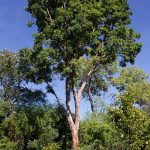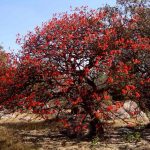TREE LIFE
June 1982
MASHONALAND CALENDAR
Saturday June 5th : 1030 hours. Botanic Garden Walk. Meet in the Car Park. The evenings are becoming shorter so we will hold our Botanic Garden Walks on the first Saturday of the month for the next three months.
Sunday June 20th : By kind invitation of Mrs. Pat Bellingham we shall go to Langford farm to visit the area at the confluence of Hunyani and Makabusi Rivers. Bus will leave the Monomatapa Car Park at 0930.
BOTANIC GARDEN WALK 4TH MAY 1982
At the last minute Mr. Tom Muller was unable to join us but fortunately Mr. Gerald Pope was still hard at work in the Herbarium identifying the specimens we had brought back from our recce to Gadzema and he very kindly volunteered to walk with us.
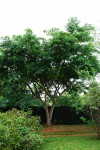
Albizia glaberrima. Photo: Steve Barrie. Source:Flora of Zimbabwe.
Our first discussion centred around Albizia glaberrima, Lowveld Albizia, simply because that is what we were walking towards. Its shape and form were lovely. Perhaps if one day we visit the low altitude mopane woodland in the eastern part of the country, we will be able to see it in the field. Consulting the literature I see that it is remarkably similar to A. antunesiana with which we are all familiar by our purple leaved Albizia is much more widespread, occurs at higher altitudes and has leaflets that have a markedly pale under surface so we are unlikely to confuse them. The next trees to catch our attention were also from the eastern districts but this time a forest margin species. They were Rothmannia manganjae, scented bells, in flower, with the reddish and purplish markings in the throat of the creamy white flower. Rothmannia fischeri, woodland Rothmannia, which we often see though seldom in flower, also has creamy white flowers, but the purplish markings are on the outside of the flower.
And then we reached our first destination, Antidesma venosum, the Tassel-berry, so called because the small fruit are borne massed on long pendulous spikes. This is a member of the family EUPHORBIACEAE and like many members of that family is dioecious, which means it has the sexes separate on different trees (dioecious comes from the Greek – dis means twice and oikos means house). I also promised to look up the meaning of venosum. “Venose” with many and prominent veins and is the word with venomous which comes from the Latin venenum meaning poison.
There was a lovely Cassia singueana in flower. This is what we know as the Winter Cassia. Last year they did not flower until mid-July and this year they started flowering early in April. Mostly we see them as large shrubs or maybe small trees but the one we admired in the Botanic Gardens was one of the finest specimens we have seen. Was it planted or is it growing there naturally?
Eventually we arrived at what I was hoping everyone would see, Pteleopsis anisoptera, as this will be one of the highlights of our trip to Gadzema. In this country between the two members of COMBRETACEAE which we know well Combretum and Terminalia come two other genera (1) Meiostemen with a single species M. tetranclus which is called the False Combretum and occurs in the Zambezi Valley. It has flowers with 4 stamens, the only feature which separates it from Combretum which has 8 to 10 stamens. (2) Pteleopsis of which there are 2 species P. anisoptera which has 4 to 5 wings, Combretum like fruit with a distinct apical peg (i.e. a little point at the end) and P. myrtifolia with 2 to 3 winged, Terminalia like fruit, although as we saw they are also often 4 winged but the apical peg is missing. I cannot help feeling that having made those statements on the differences between the two species, that fools rush in where angels fear to tread, and now quote from Kirkia Vol. 7 Part 2. COMBRETACEAE by A.W.Excell : “Although I have maintained P. myrtifolia and P. anisoptera, I hesitate to call them “distinct species” for scarcely any single character will separate them infallibly and they probably hybridize. The following notes may help to identify most specimens (the most difficult are young flowering specimens without fruits or mature leaves). (1) If some fruits are 2-winged; almost certainly myrtifolia. (2) If many of the fruits are 4-winged; probably anisoptera. (3) If the fruits are 1.5 cm long or longer; probably myrtifolia. (4) If the fruits are 1cm long or shorter; probably anisoptera (5) If the leaves are acuminate (even slightly so or some of them); almost certainly myrtifolia. (6) If the leaves are somewhat shiny on the upper surface; probably myrtifolia (7) If the leaves are matt on the upper surface; almost certainly anisoptera (8) If the petioles are relatively long and slender; almost certainly myrtifolia. (9) If most of the fruits have distinct apical pegs: more probably anisoptera (but some fruits of myrtifolia have pegs) (10) If there are rather conspicuous conical glabrous buds 2.5-3cm long in the axils of the leaves (or fallen leaves): probably anisoptera. (11) If the specimen shows considerable variability in some of the above features and a puzzling mixture of characters: probably a hybrid.”
By the time the above appeared in Flora Zambesiaca Vol. 4 he had added the following paragraph “The ecology of the two species is mainly similar but P. myrtifolia is recorded in our area in evergreen and riverine forests which is not the case for P. anisoptera”.
The Pteleopsis anisoptera which we shall see at Gadzema are mainly riverine albeit not forest!
While in the COMBRETACEAE section we had a look at some of the other species: Combretum imberbe, with its grey green crinkled leaves; Terminalia sericea with its silver leaves and peeling twigs; also with peeling twigs was Terminalia brachystemma, the Kalahari Sand Terminalia and Terminalia trichopoda, perhaps a valid species, perhaps a phantom species, perhaps a hybrid between T. sericea and T. stenostachya – or something. To each Botanist his own theory. With its leaves in rosettes and its twigs not peeling or flaking was T. stenostachya. Perhaps the one we see most frequently, particularly at slightly lower altitudes.
We then rushed over to the Fig section to remind ourselves what Ficus soldanella, now Ficus abutilifolia is like. With its huge round shiny leaves with a lobed base and pink or yellow midribs, veins and petioles we should have no difficulty recognising it on our forthcoming visit.
And finally in the gloaming we wandered down the new stream – by then switched off for the night, but none the less reminiscent of a stream through an area of typical eastern district vegetation.
Thank you Gerald for your company and knowledge and for joining us un-rehearsed and un-briefed. I am sure all enjoyed their walk including the final dash to the cars in the dark. The overcast sky had brought the early dark earlier.
IJAPO FARM 16TH MAY 1982
On Sunday 16th May there was frost and that was also the occasion when we decided on a departure time of 0730 hours – to my knowledge the first time the bus has left as early as that. Despite the combination of an extra early start and an extra nip in the air I am delighted to say I heard no mutters and would like to think that all were so full of confidence of the beautiful day to come that the early inconvenience was of no comment. And there was no doubt that the beautiful day did come! Someone asked “How do you find all these beautiful places for us to visit?” On this occasion Doug and Lola Irvine not only suggested the venue but made all the arrangements including taking Paul and I down for a week-end to do a recce. And, of course, none of it would have been possible without the interest and enthusiasm and hospitality of Roger and Anne Green. And talking of hospitality, this included tea and eats for us when we arrived. I might add that our early departure lead to an earlier than expected arrival and I gather that while we were de-bussing and stowing our picnic things on the truck, knives were flying putting butter on the scones. The tea was most welcome and the scones were gorgeous.
Refreshed we set off. In the first paddock there were a few cattle which kept the grass short so we were able to see the trees easily. There was a Gardenia ternifolia, used to be G. jovis-tonantis, in fruit, with rather unribbed, ovoid, olive green fruit as opposed to the rounder, ribbed, blue green one of Gardenia volkensii, used to be G. spatulifolia. I have found the Gardenias rather difficult to distinguish between and have now looked up the differences : Gardenia ternifolia should have leaves which are rough to touch, caused by the presence of scab rid hairs on both surfaces; the bark should be rusty powdery and the growing tip should be round while G. volkensii should have smoother leaves, smoother bark, a pointed growing tip and scaly ribbed round fruit. Most trees in the first part of the paddock were smallish and then just next to an anthill right on the path and with a branch full of fruit broken so as to come down to our level and no doubt that of other fruit gatherers was one of the highlights of the day, Diospyros squarrosa. The outstanding feature of this tree is the leaf shape, obovate – upside down egg shape and the fruit which have 4 persistent calyx lobes bending back. “Squarrose” means “rough with projecting scales and rigid leaves” and the “rigid leaves” describe beautifully the still leaf like calyx lobes coming out from the stalk of the fruit.
Abrus precatorius was the next thing which caught our eyes. This is not a tree nor even a shrub but a slim-stemmed climber and although for the most part it was well below knee level its spectacular seeds were eye catching. However, there was an Kirkia acuminata festooned with lucky bean seeds. The pods which resemble pea pods are clustered together and split open revealing the seeds, red tipped with black which stay attached to the dried split-open pod. The whole is most striking. The resemblance to Erythrina seeds is not really surprising when one realizes that Abrus is next to Erythrina in botanical order. The Kirkia with lucky bean seeds was in fact one of a group next to the fence, all in full autumn leaf and as striking in the distance as the Abrus beans were close up. Just before we left the paddock we veered to the right to admire a lovely Garcinia buchananii, another name change, this was G. huillensis, still exuding its yellow sap. We then decided to make straight for the two Monotes, Monotes engleri and Monotes glaber were growing together and we would be able to compare them. But before we reached that spot there were several distractions including Strychnos innocua with its powdery yellow bark; Boscia salicifolia with its very prominent midrib on the under surface; Crossopteryx febrifuga, characteristically a RUBIATE with pink tinged petioles or leaf- stalks. Monotes glaber is the Monotes with its yellow leaves and is the species with which we are most familiar. Monotes engleri has leaves with a blue green upper surface and a very white under surface, in fact, looking for all the world like a Parinari curatellifolia, mahash, or Mbola plum with Monotes fruit at a distance; close up, of course, both Monotes species have an extra floral nectary, i.e. a nectar gland at the base of the midrib of the leaf just before the petiole. It appeared that the gland on Monotes engleri was much bigger than that of Monotes glaber.
Eventually we reached the river and did our best to divert all along the path to the right while I tied a yellow flag on the most prominent tree in order to guide everyone back across the river to the right spot. Once again progress – in terms of distance covered – was very slow. Acacia goetzei subsp. goetzei with its leaflets more than 3mm was the dominant Acacia.
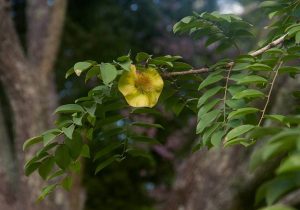
Pterocarpus angolensis. Photo: Bart Wursten. Source Flora of Zimbabwe.
Pterocarpus angolensis, mukwa, with its unmistakable pods was eye catching and away from the path among huge boulders towered Brachystegia glaucescens, Mountain Acacia. There were some closer to the path which gave rise to a discussion about hybrids and their possibilities. There was, or could have been, something not quite right. I must confess to having taken the line of least resistance by deciding that when I know all the trees I will be able to concentrate on that grey area of hybrids. Along that path were also Ormocarpum kirkii, fascinating with their pods resembling little green caterpillars tucked into the dry persistent flower petals. There was a Vitex payos, the fruit only just over and Ximenia caffra, very hairy and brownish yellow, which could not possibly be mistaken for X. americana despite having no fruit. And then, as we went down the slope another excitement, another member of the same Family OLACACEAE, Olax obtusifolia which has ovate (egg shaped) blue green leaves, rather fleshy looking, almost no petiole and a notch in the rounded tip.
Then we reached a cliff and after admiring the rocky river below had to clamber along the side of a steep bank before we could descend. Along that bank was another species of Abrus – this time Abrus schimperi. If I could find a description I am sure it would be described as a shrub. In fact I collected a specimen on the recce expecting it to be an Indigofera but Indigofera species have biramous hairs. There is no funny business about “h’s” and little characters. Biramous is a word straight out of an English dictionary and means “having two branches, forked”. So a biramous hair has a stalk which branches horizontally on either side so that if you have a microscope or lens and can see to push one end of the horizontal bit the others end will tip up rather like a see saw. Practically if the specimen apparently has long flat hairs they could be biramous and that could be an Indigofera. The seed pods of this species looked superficially like A. precatorius but were not in bunches and did not split open. Had it done so it would have revealed flat brown seeds and not the lucky bean seeds of the creeper.
We then dropped to the bed of the Umfuli River, flanked by Aloe excelsa, some smallish other up to 12 – 15 feet tall, as yet not even in bud. At the bottom some saw and some bi-passed the Pteleopsis anisoptera which I have described very fully in the notes about the Botanic Garden Walk. And then we were out on the rolling rocks of the river. In nooks and crannies the pebbles which included agate and jasper had accumulated and several people added a bit of stone to the leaves and pods they were carrying. Some crossed the river and started wandering back along the other side. Having stuck my neck out and said that there was a Manilkara mochisia down stream, or rather down rock, several people came with me to find it. We did eventually find it, where the river in flood must rush over it, but it was so small and stunted. However, the leaves were quite recognisable with almost no petiole, characteristically in rosettes and exuding a milky sap, as do all species in the family SAPOTACEAE, of which there was another member present which was almost in profusion; Mimusops zeyheri with its comparatively long petiole up to 3cm, one and a quarter inches. There were also ficus ingens, having been identified previously, distinguishable from Ficus salicifolia by having the base of the leaves cordate, heart shaped, and larger figs. Those of Ficus salicifolia are only about 5 – 8mm in diameter which turn white while those of F. ingens are 10 – 13mm; Margaritaria discoidea, still on our cards as Phyllanthus discoideus, with its small red branchlets and leaf margins rolled under; Erythroxylum emarginatum with a harder textured leaf showing a notch in the apex.
On the way back we admired both Paper bark trees. Albizia tanganicensis, paper bark Albizia, which had shed most of the red paper from their white trunks and Commiphora marlothii with the yellow paper hanging from their green trunks. Also with a pale trunk growing right in the rocks was Ficus abutilifolia which is the new name for Ficus soldanella, with its huge round slightly fleshy leaves with pink or yellow petioles and main veins. Without its expected pale trunk we slid down past Boscia angustifolia. Its hard narrow leaves have a little point like a thorn on the tip. The Baobab, Adansonia digitata of course attracted a lot of attention but the Afzelia quanzensis, pod mahogany, next door with hardly any leaves and no pods was inclined to be overlooked.
Finally we made our way down to the bottom, crossed the water and clambered up the other side over tumbled boulders, smooth rock and small streams to what was by then welcome refreshment. After lunch the very weary rested, one party explored the river including a huge island in the middle and another party made their way over to some granite kopjes where we had collected Combretum psidioides on the recce and which proved to be a new record for the area. This is the peeling twig Combretum, the bark on the young branches always peels leaving an exposed cinnamon surface rather reminiscent of the peeling of Terminalia sericea. “Psidioides” means like Psidium, the guava, and probably refers to the peeling bark tendency; certainly there is no other apparent resemblance. We also saw Hippocratea parvifolia exhibiting more its liane habit rather than that of a tree but they did have fairly stout trunks. This often appears to have compound leaves growing out of the axils of the simple leaves. It would seem that the bud in the axil of the simple leaf does its own thing and shoots forming a little spray of leaves looking like leaflets. All the leaves really are simple. Another unusual find was Markhamia acuminata, unmistakable with its long pods which had split open and already dispersed some of the papery winged seed. Incidentally, fresh seed germinates very well and I am now embarrassed by the number of seedlings I have. Would anyone like one? And then it was time to make our way back to the bus. Anne again had copious pots of tea to refresh us before departure. The end of a long and lovely day. Thank you Roger and Anne for sharing that special place “Ijapo” with us.
MATABELELAND CALENDAR
Sunday June 6th : To Gordon Park Scout Camp, R.M. Nat. Park. Please bring a hammer for fixing names to trees in preparation for the Zimfar to be held there in August. There are discs to be removed from trees from a labelling long ago. Meet at Retreat Shopping Centre at 0830 hours. There will be braai fires if you wish to use them.
Sunday July 11th : As the leaves appear to be falling early this year we will probably join the OAZ for a combined ecological field meeting which may include a walk along the Maleme River from the Arboretum.
The weather did not look too promising for our return visit to the Kalahari Sand area on 2nd May, but by the time we arrived at Rudy Farm the clouds had cleared and we quickly got to work filling bags with the required 200 seeds each from Peltophorum africanum, Terminalia sericea, T. brachystemma, Combretum hereroense and C. psidioides and Grewia bicolor.
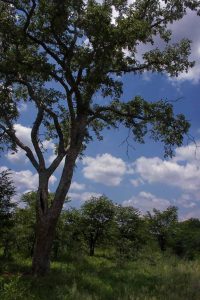
Xeroderris stuhlmannii. Photo: Bart Wursten. Source: Flora of Zimbabwe
Since our previous visit, our mystery trees had been identified as Xeroderris stuhlmannii. There was some excitement when we decided we had found a Ziziphus abyssinica even though it should not occur in the area – but it proved to be a mucronata subsp. rhodesica, with soft hairy leaves. On the flat sand velt Dalbergia melanoxylon and Baikiaea plurijuga reached a fair height and four species of Grewia – G. bicolor, G. flavescens, G. monticola and G. retinervis – were numerous. This area, although only 22km from Bulawayo, produces an exciting change of vegetation, and with it a lot of research and occasional arguments! The Teak cattle grids were a fine tribute to the durability of the wood.
-B.Blake
We have recently received a booklet produced by the National Academy Press, Washington DC, called “Sowing Forests from the Air”. Paul has done the following brief summary :
“The primitive method of broadcasting seed or direct sowing has long since given way to the more sophisticated method of growing seedlings in nursery beds and planting out evenly spaced forests which require less seed, give enhanced seedling survival rates, making tree growing more reliable and give the trees a healthier start. But it is far too slow to keep up with the world rate of deforestation which in many parts has reached critical proportions. Some countries, Haiti, for instance, have essentially eliminated their forests while many others could reach total deforestation before 1990. The deforested land is often lost to coarse, almost useless grasses or to a wilderness of shrubs and scrubby trees of little or no value. When the tree cover and their root systems have been removed, heavy rains cause rushing water that erodes the land and produces devastating floods. There is no end in sight; ever swelling numbers of local farmers cut and burn the forest for land to grow crops and more and more villagers harvest trees for fuel wood as escalating prices preclude the use of kerosene for cooking and heating.
These enormous areas of virtually unproductive land are increasing, some 25 million hectares exist in Thailand, the Philippines and Indonesia, and in many other areas including the Amazon forest of Brazil, in Madagascar and in the relict montane forests of Northern Tanzania, the present rate of deforestation is so great that within about 10 years most virgin forests will be extinct.
Aerial reforestation is not a replacement for planting seedlings by traditional methods; it is best considered as an additional tool for foresters to use when the sites, needs and species are appropriate. Dropping seed from planes or helicopters is a well known and well established technique for sowing pastures and agricultural crops. The break through as far as forests are concerned was made in 1953 and 1956 when seed coatings repellent to birds, insects and rodents were discovered.
Today aerial seeding is already regarded as a practical reforestation technique and more than a million hectares of well stocked forests in the United States, Canada, Australia and New Zealand demonstrate its success, particularly on difficult inaccessible ground. It has mainly been used in temperate areas but it would seem that the techniques could be modified for use elsewhere but whether it will be successful in the arid tropics is still unknown. It has been used mostly with conifers and eucalypts although other species that re-seed themselves successfully in a given region could also be aerially seeded with reasonable probability of success. Characteristics that make seed suitable include its ability to germinate on the soil surface although small seed will fall down cracks giving it a better chance; fast germination and rapid development of a deep tap root and seed that is easy to collect in large quantities and to store for long periods.
In good weather an aircraft can routinely sow 1 200 to 1 500 hectares daily and costs about one tenth as much as hand planting. It is most economical for areas greater than 200 hectares. The greatest cost is that of the seed itself which is required in large quantities; in the United States pine seed costs about $50 per hectare spread at a rate of 0.85kg per hectare. The aeroplane itself can usually be easily adapted from those already in use for pest control or aerial surveying. A seed hopper is required with some sort of mechanism to ensure even flow and distribution. With fixed wing aircraft gravity flow of seed and an unpowered venture-type distributor can be used while helicopters, because of their slower speed need power driven augers and slinger-type distributors. Which means that the seed is fed into the slinger by a spiral similar to that in a mincing machine and the slinger throws it far and wide by means of its power driven rotating, curved, hollow arms, like that of some lawn sprinklers.
Aerial seeding is not a method to be applied casually. It is more subject to environmental uncertainties than the planting of nursery stock. Correctly used, it is cheap, fast and reliable but the forest manager must learn where this method is better than alternative techniques. The area that is to be seeded must be properly studied as to numbers and types of predators present, etc. and in many cases the ground must be disked or tyned to prepare it for the seed. The most important point is that the species chosen must be the correct one, best able to withstand the hazards of survival on the ground below.
I wish I could show you the photographs, especially the one of a 7 year old planting of loblolly pine in Alabama, U.S.A. which turned an arid waste-land into a dense forest which, after 20 years, has become home to deer, quail, water fowl and beaver. Nearby streams and ponds are clear and stocked with fish.”
COMMENT Although this booklet carries a message of hope for the world and the reforestation of denuded areas is vitally necessary for our survival, it is only the plants that give us the oxygen we breathe, it is never-the-less rectifying a wrong that should never have been allowed to happen. Imagine all our bundu with its wealth of species having to be replaced by a stand of loblolly pine! And this is not far-fetched. There is an area 13 miles from town on the Beatrice road which we have loved, have called “our Ochna pulchra kopjes” and have wanted to take the Tree Society there for many years. Today the granite boulders of these kopjes are standing as islands in bare grassland. At least the Government is actively spreading propaganda and interest in planting and so preserving trees, but is it enough? Will we be able to halt the present increasing destruction of our woodland so that it will not be necessary to have an exercise in reforestation by loblolly pine?
-P. Coates Palgrave


